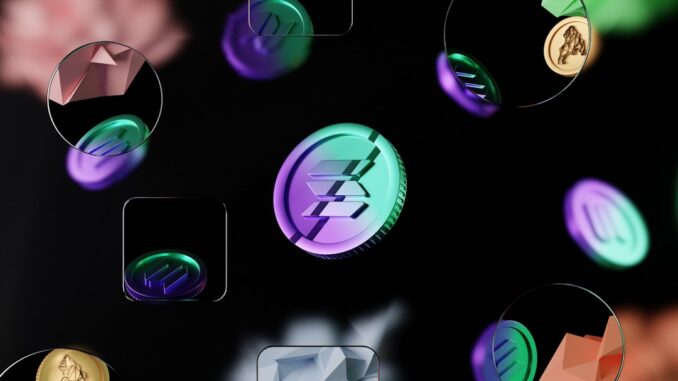
Summary
$SOLX, a Layer-2 scaling solution for Solana, launched on June 23, 2025, after raising $58 million in its presale. The token experienced significant price volatility after launch, but shows potential for future growth given its utility and the growing Solana ecosystem. The coming weeks are crucial for Solaxy as it prepares to launch its mainnet and other ecosystem components.
Assistance with token financing
Main Story
So, you’ve probably heard the buzz about Solaxy ($SOLX), right? It’s aiming to be the first Layer-2 scaling solution specifically built to supercharge the Solana blockchain. And, honestly, it’s about time someone tackled Solana’s congestion issues head-on. Solaxy promises faster transactions, lower fees, and better scalability for all those decentralized apps, or dApps, that we’re seeing pop up. They even had a pretty impressive presale back on June 23, 2025, raking in a cool $58 million. Not bad at all!
The SOLX token then launched simultaneously on Uniswap (on Ethereum) and Raydium (on Solana), starting at about $0.00182. But here’s where things get interesting.
$SOLX Launch and Price Volatility
The launch of $SOLX was… well, let’s just say it wasn’t a smooth ride. We saw some serious price swings. On Uniswap, the price took a nosedive – a 68% drop to $0.0005821 within just 35 minutes! Things seem to have calmed down a bit, with trading hovering around $0.0011 which is still about a 40% decrease from the initial listing. Raydium, on the other hand, saw an even more dramatic plunge; an 88% drop to $0.0002092 in the second hour after launch. Ouch.
It’s not all doom and gloom though. The token’s shown some grit, bouncing back to around $0.00114. As of today, June 27, 2025, it’s down about 37% from the initial price. But, remember these numbers are as of today and, you know, crypto prices? They can change faster than I can finish my morning coffee. So, do your own research, people!
Solaxy’s Ecosystem and Utility
Okay, so Solaxy isn’t just about the token, it’s building a whole darn ecosystem. They are talking about a blockchain explorer, a cross-chain bridge connecting Solana and Ethereum (smart move, if you ask me), a decentralized exchange (DEX) called Neptune, staking infrastructure (which we’ll get to), and even a native launchpad called Igniter Protocol. That’s a lot. And get this: the SOLX token is supposed to be the fuel that powers everything, for transaction fees, staking, and even for getting involved with future platform features. All in all, it sounds well thought out.
Upcoming Milestones and Long-Term Potential
Looking ahead, Solaxy’s got some pretty big milestones coming up. They’re planning to launch the Layer-2 blockchain mainnet, along with that blockchain explorer and cross-chain bridge, on July 7, 2025. Then, Neptune, their DEX, is slated for July 14, 2025, followed by Igniter Protocol on July 21, 2025. These are absolutely pivotal for Solaxy. Why? Because it’s their chance to show they can deliver on what they’ve promised. No pressure, right?
Now, everyone’s got an opinion when it comes to long-term price predictions for $SOLX. Some analysts are really optimistic, talking about prices as high as $0.20 by 2030. That’d be a hefty return for early investors, wouldn’t it? But others are playing it a bit cooler, pointing out that we could see some bearish market trends, and that could throw a wrench into things.
Ultimately, Solaxy’s fate depends on whether they can actually solve Solana’s scaling issues, attract dApp developers to their platform, and get people to actually use it. Easier said than done, of course. But, fingers crossed!
Staking Rewards and Investor Interest
One thing that’s definitely caught people’s attention is Solaxy’s staking model. They’re advertising APYs up to 68%! That’s pretty eye-catching, especially for those looking to earn some passive income. But, here’s a word of caution: high APYs usually mean higher risk. Just something to keep in mind.
Solaxy’s Dual-Chain Approach
I think Solaxy made a smart move by deciding to operate on both the Ethereum and Solana blockchains. It gives them more flexibility and, if one chain gets bogged down or the fees get too high, they’ve got another option. It’s a smart mitigation strategy. This multi-chain approach could attract more users and developers, too. More reach, more possibilities. It seems obvious in hindsight, doesn’t it?
Navigating the Crypto Landscape
Look, investing in crypto is always a gamble, let’s be honest. No one can guarantee price predictions, so beware of who you’re listening to. You’ve really got to do your homework, understand the project inside and out, and figure out how much risk you’re willing to take. That said, the price volatility we saw after the $SOLX launch isn’t really that unusual. It happens, especially with new tokens hitting the market. The next few weeks and months will be the make-or-break period for Solaxy. If they can successfully launch the mainnet and other ecosystem pieces, that’ll be a huge signal that they’ve got a shot at long-term success.


Be the first to comment